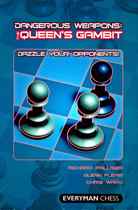Dangerous Weapons — Queen’s Gambit
Chris Ward, Glenn Flear, Richard Palliser

Everyman Chess has been one of the major publishers in the chess world for some time, but that hasnt caused them to rest on their laurels. A few years ago they came up with the Dangerous Weapons concept. The idea was to publish a book on a single opening with a series of easily digestible chapters focusing on specific variations. Typically, these would be on less known lines offering the virtues of surprise and limited theory yet still packing a punch.
The latest in the series, Dangerous Weapons: Queens Gambit, authored by the team of Richard Palliser, Glenn Flear and Chris Ward, is divided into 14 chapters (10 written from Whites point of view) which cover pretty much all Blacks major defenses after 1.d4 d5 2.c4.
They are:
Versus the Slav:
1.d4 d5 2.c4 c6 3.Nf3 Nf6 4.Nc3 dxc4 5.a4 Bf5 6.Ne5 e6 7.f3 and 6…Nbd7 7.Nxc4
6.e3 e6 7.a5
5…Bg4 6.Ne5 Nbd7
4…a6 5.c5 Nbd7 6.Bf4 Nh5 7.Bg5
Semi-Slav:
4…e6 5.Bg5 h6 6.Bxf6 Qxf6 7.Qb3 dxc4 8.Qxc4 Nd7 9.0-0-0
5…dxc4 6.e4 b5 7.e5 h6 8.Bh4 g5 9.exf6 gxh4 10.Ne5 Qxf6 11.g3.
Queens Gambit Declined:
1.d4 d5 2.c4 e6 3.Nc3 Nf6 4.cxd5 exd5 5.Bg5 Bb4
5.Bg5 Be7 6.e3 c6 7.Bd3 Bg4
4.Nf3 Be7 5.g4
4.Nf3 dxc4 5.e4 Bb4 6.Bxc4
Tarrasch:
1.d4 d5 2.c4 e6 3.Nc3 c5 4.cxd5 exd5 5.Nf3 Nc6 6.Bf4 (also with coverage on the Hennig-Schara Gambit 4.cxd5 cxd4 as well 5.e4 dxe4 6.Bc4 cxd4 7.Qb3)
Albin and Chigorin:
1.d4 d5 2.c4 e5 3.dxe5 d4 4.a3 Nc6 5.e3 or 1.d4 d5 2.c4 Nc6 3.e3 e5 4.dxe5 d4 5.a3
As is typical for the series, some lines are solid with plenty of GM pedigree (for example 7.a5) while others are definitely on the experimental side (5.g4 in the QGD). The material on the Queens Gambit Accepted (22 pages) is somewhere in between and offers Black a mini repertoire versus 1.d4 d5 2.c4 based on attempts by Black to hold on to the c4-pawn for awhile 1.d4 d5 2.c4 dxc4 3.e4 b5 and 1.d4 d5 2.c4 dxc4 3.e3 Be6 4.Nf3 c6.
The biggest surprise for this reviewer was the reasonable positions Black reached from the Hodgson-Smallbone variation, named for the English GM and strong British amateur who championed 1.d4 d5 2.c4 c6 3.Nf3 Nf6 4.Nc3 dxc4 5.a4 Bg4 6.Ne5 Nbd7 with the idea 7.Nxg4 Nxg4 8.e4 e5! Of course 8.e4, tempting as it might be, is hardly forced, but Blacks position after alternatives is also quite reasonable.
While chapters are aimed at playing a particular color, the authors are not full-time cheerleaders. One example of their objectivity occurs in the Moscow variation line where GM Ward likes 5…h6 6.Bxf6 Qxf6 7.Qb3 dxc4 8.Qxc4 Nd7 9.0-0-0!?. After 7…a5!? his main line goes 8.e4 dxe4 9.Nxe4 Bb4+ 10.Kd1 Qf4 11.Qe3 Qxe3 12.fxe3 Be7 13.c5 0-0 14.Ne5 Nd7 15.Nc4 Rd8 16.Kc2 e5 17.Ned6 exd4 18.exd4 b6 (Sulava – G. Timoscenko, Arca 1999), considered a little better for White by both Ward and IM David Vigorito in his new book Play The Semi-Slav. Ward then suggests instead 18…Nf6!? with the idea of meeting 19.Re1 with 19…Be6 jettisoning the b-pawn for good counterplay. This is above and beyond the call of duty!
If you play 1.d4 and are perhaps searching for a new weapon against the 4…a6 Slav or Albin, if you already play the Slav as Black and are looking for second weapon without much more study (think 5…Bg4 6.Ne5 Nbd7) or just looking for something completely new against 1.d4 (non-theoretical QGA) then Dangerous Weapons: Queens Gambit will be a very useful acquisition.
Recommended
